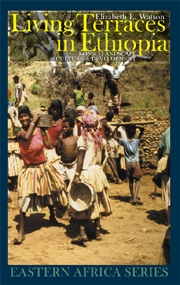Book contents
- Frontmatter
- Contents
- List of Photographs
- List of Maps, Tables & Figures
- Acknowledgements
- Foreword
- Introduction: Konso Landscape, Culture & Development
- 1 Konso Intensive Indigenous Agriculture
- 2 Social Life of Agriculture
- 3 Ritual Life of Agriculture
- 4 Political Life of Agriculture
- 5 Modernity & Christianity
- 6 Revolutionary State
- 7 Ethnic Decentralization & Self-determination
- Conclusion: Landscape, Meaning & Development
- References
- Index
1 - Konso Intensive Indigenous Agriculture
Published online by Cambridge University Press: 12 September 2012
- Frontmatter
- Contents
- List of Photographs
- List of Maps, Tables & Figures
- Acknowledgements
- Foreword
- Introduction: Konso Landscape, Culture & Development
- 1 Konso Intensive Indigenous Agriculture
- 2 Social Life of Agriculture
- 3 Ritual Life of Agriculture
- 4 Political Life of Agriculture
- 5 Modernity & Christianity
- 6 Revolutionary State
- 7 Ethnic Decentralization & Self-determination
- Conclusion: Landscape, Meaning & Development
- References
- Index
Summary
The Konso people live on and around a small range of mountains, some 600 km south of Addis Ababa, in the Rift Valley of Ethiopia (see Map 1.1). These mountains rise to a height of 2,500 m, and from above 700 m they are scored with neat, dry stone terraces (Amborn, 1989). To the outsider, the area is distinctive in many ways: the terraced landscape marks it out as different from the hot lowlands that surround the mountains, and from the other cultivated mountains in the area. In the area marked on the map, they also speak their own language, Afa Xonso, an Eastern Cushitic language. It has some links to Oromiffa spoken by the Boran and the Guji to the east, and other links to the Dirashe to the north-west, but the languages are not mutually comprehensible. The Konso are also recognizable by their style of dress: women often wear thick home-spun cotton skirts which are gathered and folded into two layers; the men sometimes wear home-spun and woven cotton shorts, often striped and brightly coloured.
Konso villages are nucleated, walled and extremely dense and compact. The density of the settlements and the way in which they are criss-crossed by many narrow and labyrinthine paths led Hallpike (1972) and others, Sutton (1989), to describe these settlements as towns. Though in many ways this word is appropriate, it is less confusing to describe them as villages, distinguishing them from the more urban recent settlements of, for example, Fasha and Karate, both of which have grown up around market places. Karate is the main town, and the location of government offices.
- Type
- Chapter
- Information
- Living Terraces in EthiopiaKonso Landscape, Culture and Development, pp. 25 - 53Publisher: Boydell & BrewerPrint publication year: 2009



